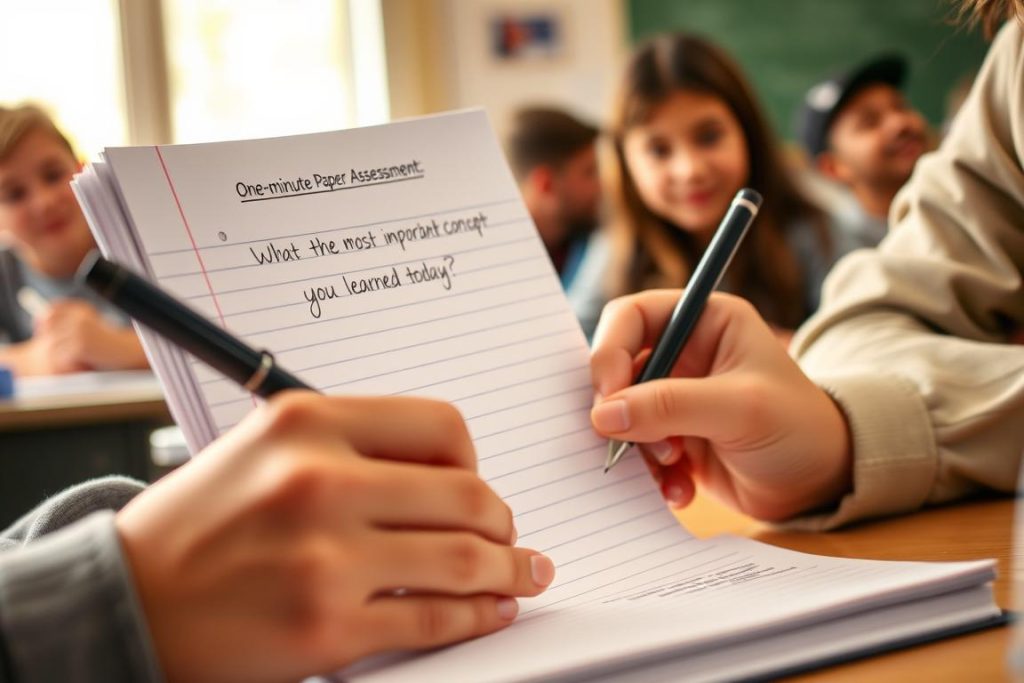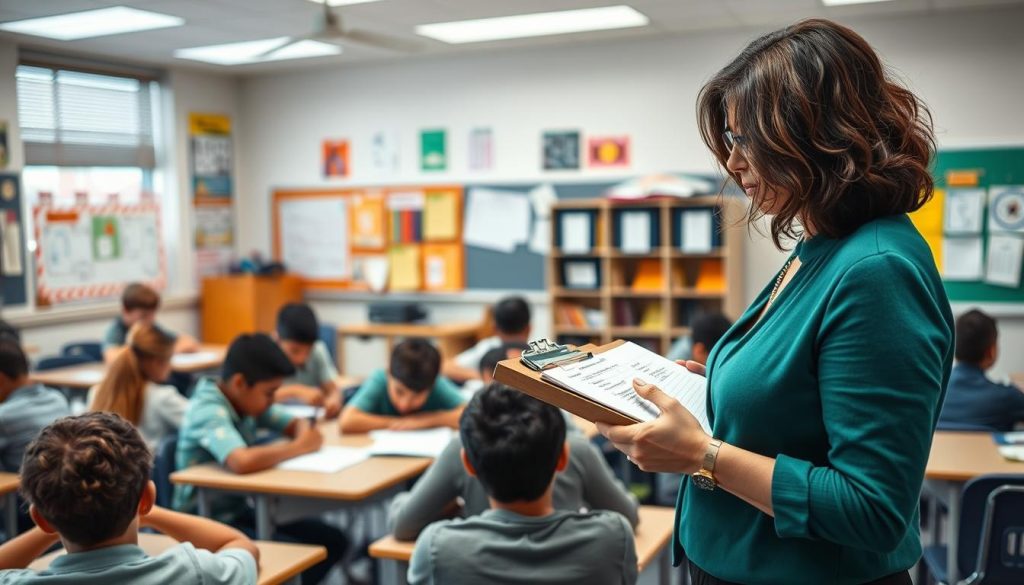In this comprehensive guide, we’ll explore practical formative assessment strategies that you can implement immediately in your classroom. You’ll discover how these techniques not only measure progress but also empower students to take ownership of their learning journey. Let’s dive into the world of formative assessment and transform how you track student growth.
Formative assessment allows teachers to gather real-time data on student understanding
Understanding Formative Assessment and Its Impact on Learning
Formative assessment isn’t just another educational buzzword—it’s a powerful approach that transforms how we understand student learning. At its core, formative assessment involves gathering evidence about student understanding during the learning process, not just at the end. This ongoing evaluation allows teachers to make immediate adjustments to their instruction, addressing misconceptions before they become deeply ingrained.
According to a study by the Organization for Economic Co-operation and Development, formative assessment has been proven highly effective in raising student achievement, increasing equity of outcomes, and improving students’ ability to learn. When teachers develop their teacher skills in formative assessment, they create learning environments where feedback flows continuously and students become active participants in their educational journey.
Unlike summative assessments (like final exams or standardized tests), formative assessment isn’t about assigning grades. Instead, it focuses on providing feedback that moves learning forward. Think of it this way: when a chef tastes the soup during cooking, that’s formative assessment. When a customer tastes the finished soup, that’s summative assessment.
Key differences between formative and summative assessment approaches
Enhance Your Formative Assessment Skills
Looking to develop your teacher skills in formative assessment? Explore our specialized professional development courses designed specifically for K-12 educators.
7 Effective Formative Assessment Strategies for Immediate Classroom Implementation
Implementing formative assessment doesn’t require complex tools or extensive preparation. Here are seven practical strategies you can start using tomorrow to enhance your teacher skills and gain valuable insights into student understanding:

Exit tickets provide quick insights into student understanding at the end of a lesson
1. Entry and Exit Tickets
These quick written responses at the beginning or end of class provide immediate feedback on student understanding. Entry tickets can activate prior knowledge or check homework comprehension, while exit tickets assess what students learned during the lesson. For example, ask students to summarize the main point of today’s lesson in three sentences or identify one question they still have about the topic.
Pro tip: Use colored sticky notes for exit tickets and have students place them in designated areas labeled “I understand completely,” “I mostly understand,” or “I need more help.” This visual organization helps you quickly assess class-wide understanding.
2. Think-Pair-Share
This collaborative strategy gives students time to think independently, discuss with a partner, and then share with the class. It encourages participation from all students, not just those who typically raise their hands. The teacher skills involved in facilitating effective think-pair-share sessions include asking thought-provoking questions and actively listening to student discussions to identify misconceptions.
Implementation example: After introducing a new concept, pose a challenging question. Give students 30 seconds to think silently, 2 minutes to discuss with a partner, then call on pairs to share their thoughts with the class.
3. One-Minute Papers
Ask students to respond to a focused question in writing for just one minute. Questions might include “What was the most important thing you learned today?” or “What remains unclear?” This quick formative assessment technique develops both student reflection skills and teacher skills in identifying learning gaps.

One-minute papers encourage reflection and provide quick assessment data
4. Strategic Questioning
The art of asking effective questions is among the most valuable teacher skills. Use a mix of lower and higher-order questions to assess different levels of understanding. Open-ended questions that begin with “why” or “how” encourage deeper thinking and reveal more about student comprehension than simple yes/no questions.
Try using the “no hands up” technique where you randomly select students to answer questions. This ensures all students stay engaged and prepared to participate.
5. Classroom Polls and Digital Tools
Technology offers numerous ways to quickly gather student responses. Digital polling tools allow you to pose a question and immediately see how many students selected each answer option. These tools develop teacher skills in data analysis while making assessment engaging for students.
Popular tools include Kahoot, Socrative, and even simple Google Forms. Many of these platforms automatically compile data, saving you valuable time.
6. Visual Representations
Ask students to create diagrams, mind maps, or sketches that demonstrate their understanding of concepts. Visual representations often reveal misconceptions that might not be apparent through written or verbal responses. This approach is particularly effective for visual learners and helps develop teacher skills in interpreting different forms of student expression.

Visual representations help students organize their thinking and reveal their understanding
7. Self-Assessment Checklists
Provide students with clear criteria for success and ask them to evaluate their own work. Self-assessment develops metacognitive skills and helps students take ownership of their learning. Teachers can compare student self-assessments with their own evaluations to identify areas where students may be overconfident or underconfident.
Ready to Implement These Strategies?
Enhance your teacher skills with practical resources designed for immediate classroom.
Digital Tools for Formative Assessment in Today’s Classroom
Technology has revolutionized how teachers implement formative assessment. Digital tools not only make gathering student responses more efficient but also provide immediate data analysis that can inform your instruction. Developing teacher skills in educational technology is increasingly important in today’s classroom environment.

Digital tools provide immediate feedback and data visualization for teachers
Here are some effective digital formative assessment tools that can enhance your teacher skills and streamline your assessment process:
Quizalize and Kahoot
These game-based platforms make assessment fun while providing valuable data. Students answer questions in a competitive format, and teachers receive detailed reports on individual and class performance. The gamification element increases engagement while still delivering meaningful assessment data.
Padlet and Jamboard
These digital bulletin boards allow students to post responses, questions, or ideas that everyone can see. They’re excellent for brainstorming sessions and checking understanding across the classroom. Teacher skills in facilitating digital discussions are valuable for making the most of these tools.
Google Forms with Flubaroo
Create custom assessments that automatically grade themselves and provide detailed analytics. This combination saves valuable time while still giving you insight into student understanding. The data can help you identify which concepts need reteaching and which students need additional support.
Flipgrid
This video response platform allows students to record short videos explaining concepts or answering questions. It’s particularly valuable for assessing speaking skills and giving voice to students who might be reluctant to participate in class discussions.
When selecting digital tools for formative assessment, consider your specific classroom needs, student access to technology, and your own comfort level. Start with one tool and master it before adding others to your repertoire. This focused approach will help you develop teacher skills in technology integration without feeling overwhelmed.
Remember: Technology should enhance your formative assessment practice, not complicate it. Choose tools that provide meaningful data and engage students without creating additional barriers to learning.
Using Formative Assessment Data to Drive Instruction
Collecting formative assessment data is only the first step—the real power comes from how you use that information to adjust your teaching. Developing teacher skills in data analysis and responsive instruction is essential for maximizing the impact of formative assessment.

Analyzing formative assessment data helps teachers make informed instructional decisions
Creating Feedback Loops
Effective formative assessment creates a continuous feedback loop between teaching and learning. After collecting assessment data, provide specific, actionable feedback to students about their performance. Then, adjust your instruction based on the identified needs. This cyclical process ensures that your teaching remains responsive to student understanding.
Differentiating Instruction
One of the most valuable teacher skills is the ability to differentiate instruction based on assessment data. When formative assessment reveals varying levels of understanding, consider:
- Forming flexible small groups for targeted instruction
- Providing additional practice opportunities for struggling students
- Offering extension activities for students who have mastered the content
- Adjusting the pace of instruction for the whole class if needed
Making Data-Driven Decisions
Formative assessment data should inform both short-term and long-term instructional decisions. In the short term, you might reteach a concept using a different approach or provide additional examples. In the long term, you might reorganize your curriculum sequence or allocate more time to challenging topics in future years.
“Assessment does not merely document what students know, it helps them learn. When teachers use formative assessment effectively, students learn twice as much, twice as quickly, and twice as well.”
– Dylan Wiliam, Assessment Expert
Developing teacher skills in formative assessment analysis takes practice. Start by focusing on one class or subject area, and gradually expand your approach as you become more comfortable with the process.
Master Data-Driven Instruction
Take your teacher skills to the next level with our specialized course on using formative assessment data to differentiate instruction and improve student outcomes.
Involving Students in the Formative Assessment Process
Formative assessment is most powerful when students are active participants rather than passive subjects. When students understand assessment criteria and take ownership of their learning, they develop metacognitive skills that benefit them far beyond your classroom. Developing teacher skills in student empowerment is essential for maximizing the impact of formative assessment.

Peer assessment helps students develop critical thinking and evaluation skills
Teaching Students to Self-Assess
Self-assessment is a valuable skill that develops students’ ability to critically evaluate their own work. Provide clear success criteria and model how to use them effectively. Start with simple self-assessment tasks and gradually increase complexity as students become more comfortable with the process.
Example activity: After completing a writing assignment, give students a checklist of key elements to look for in their work. Ask them to highlight evidence of each element and identify areas for improvement.
Implementing Peer Feedback
Peer feedback benefits both the student receiving feedback and the student providing it. To make peer feedback effective, teach students how to give specific, constructive comments that focus on the work rather than the person. The teacher skills involved in facilitating productive peer feedback include modeling appropriate language and establishing a supportive classroom culture.

Guiding students through self-assessment helps them develop metacognitive skills
Setting Learning Goals
Involve students in setting their own learning goals based on formative assessment results. When students have a clear target to work toward, they’re more motivated and engaged in the learning process. The teacher skills needed for effective goal-setting include breaking down complex standards into manageable objectives and helping students track their progress.
Consider using learning journals where students can record their goals, track their progress, and reflect on their learning journey. This creates a tangible record of growth that can be powerful for student motivation.
Student-Friendly Feedback Language
Instead of “You need to improve your topic sentences,” try “Your ideas are strong. How could you make your topic sentences more clearly connect to your main argument?”
Remember that developing student assessment skills takes time and consistent practice. The investment pays off in increased student ownership and more meaningful learning experiences.
Overcoming Common Formative Assessment Challenges
While formative assessment offers tremendous benefits, implementing it effectively can present challenges. Developing teacher skills in problem-solving and adaptability will help you navigate these obstacles and create a sustainable assessment practice.

Effective organization helps teachers manage formative assessment efficiently
Time Constraints
One of the biggest challenges teachers face is finding time for formative assessment in an already packed curriculum. To address this challenge:
- Integrate assessment into existing activities rather than treating it as an add-on
- Use quick assessment strategies like thumbs up/down or exit tickets that take minimal time
- Develop teacher skills in efficient classroom management to maximize instructional time
- Focus on quality over quantity—a few well-designed assessments are more valuable than many superficial ones
Managing the Data
Formative assessment generates a wealth of information that can be overwhelming to process. To manage assessment data effectively:
- Create simple recording systems that work for your teaching style
- Focus on patterns and trends rather than trying to analyze every piece of data
- Use digital tools that automatically compile and visualize assessment results
- Develop teacher skills in prioritizing which data points are most relevant to your instructional goals
Maintaining Student Engagement
When assessment becomes too frequent or predictable, student engagement may decline. To keep formative assessment fresh and meaningful:
- Vary your assessment strategies to appeal to different learning preferences
- Make assessment playful and low-stakes to reduce anxiety
- Connect assessment directly to learning goals so students see its relevance
- Develop teacher skills in creating authentic assessment tasks that students find meaningful
“The most powerful single modification that enhances achievement is feedback. The simplest prescription for improving education must be ‘dollops of feedback.'”
– John Hattie, Educational Researcher
Remember that implementing effective formative assessment is a journey, not a destination. Be patient with yourself as you develop new teacher skills and refine your approach over time.
Need Support With Formative Assessment?
Join our teacher community for ongoing support, additional resources, and professional development opportunities focused on formative assessment strategies.
Conclusion: Making Formative Assessment Work for You and Your Students
Formative assessment is not a one-size-fits-all approach—it’s a flexible framework that you can adapt to your unique teaching context and student needs. The most effective formative assessment practices are those that align with your teaching style, subject area, and classroom culture.

Effective formative assessment creates a positive culture of growth and learning
As you implement the strategies discussed in this article, remember that developing teacher skills in formative assessment is an ongoing process. Start small, reflect on what works, and gradually expand your assessment toolkit. The goal is not perfection but continuous improvement—both for you and your students.
By making formative assessment a regular part of your teaching practice, you create a classroom environment where feedback flows freely, mistakes are viewed as learning opportunities, and every student has the support they need to succeed. Your investment in formative assessment will pay dividends in increased student engagement, improved learning outcomes, and a more responsive, dynamic classroom experience.
“Assessment for learning is any assessment for which the first priority in its design and practice is to serve the purpose of promoting students’ learning.”
– Assessment Reform Group
We hope this guide has provided you with practical strategies and inspiration for enhancing your formative assessment practice. Remember that the most powerful assessment approaches are those that truly inform your teaching and empower your students to take ownership of their learning journey.
Continue Your Professional Growth
Explore our complete library of professional development resources for K-12 teachers, including specialized courses on assessment, differentiation, and instructional strategies.




